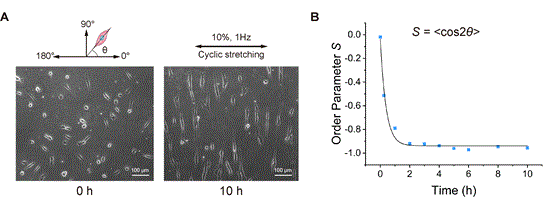 +565 975 658
+565 975 658
 info@premiumcoding.com
info@premiumcoding.com
 Monday - Friday, 8.00 - 20.00
Monday - Friday, 8.00 - 20.00
Cells can sense and respond to the mechanical stimuli in their microenvironment through the process of mechanotransduction. Uniaxial cyclic stretching has been found to influence cell behaviors, which is interdisciplinary topic among biomaterials, cell biology, biochemistry, etc. Recently, Ding’s group revealed the critical frequency and critical stretching rate for cell reorientation on a periodically stretched polymer membrane, and suggested an interpretation for the initiation of cell reorientation by use of a concept similar to chain relaxation time in polymer physics.
Ding’s group fabricated a two-layer PDMS microfluidic device that is suitable for the examination of cell behavior under uniaxial cyclic stretching by employing photolithography, soft lithography technology, and finite element analysis. The working principle of the device is: the input of negative pressure causes the deformation of the gas channels and the stretching of membrane under the flow channel, which results in cyclic stretching of cells adhering to the PDMS membrane. Simultaneous real-time cell observation, cell culture, and cell stretching were achieved by leveraging an integrated system consisting of the microfluidic chips, a computer-controlled pressure controller connected to a vacuum pump, and an inverted fluorescence microscope equipped with temperature and gas controllers.

Figure 1. Schematic presentation of the exploration of underlying effects of stretching frequency on cell behaviors in response to cyclic stretching by using a two-layer PDMS microfluidic device.
Ding’s group verified the perpendicular alignment of cells to the stretching direction under appropriate stretching conditions by use of the aforementioned two-layer PDMS microfluidic chip.

Figure 2. Cell reorientation induced by uniaxial cyclic stretching. (A) Phase-contrast images of hMSCs before (0 h) and after (10 h) the mechanical stimulation. An amplitude of 10% and a frequency of 1 Hz were set. The black double-headed arrow indicates the direction of stretching. (B) The variation of order parameter S with time.
By employing the tensegrity model originating from architecture, Ding’s group deduced the relationship between cell reorientation and free energy variance and the dynamic evolvement of the reorientation process with time for cells adhering to the substrate subjected to uniaxial periodic stretching. Theoretical calculations indicated that the preferable orientation angle of cells should be 90° under uniaxial oscillatory stretching and the time-course of order parameter is supposed to conform to the exponential decay equation, which is consistent with the experimental results. This is one of the few theoretical work that can process coarse-grained cell models and provide analytical solutions.
Ding’s group then investigated the behaviors of human mesenchymal stem cells (hMSCs) under oscillatory stretching with different stretching frequencies and amplitudes. The threshold amplitude of cell reorientation was verified. Meanwhile, cells with an initial random orientation were confirmed to be reoriented perpendicular to the stretching direction at frequencies greater than a threshold value, which we term critical frequency (fc); additionally, the critical frequency was amplitude-dependent: a comparatively high frequency was required to initiate the cell reorientation response for the stretching with a low amplitude.

Figure 3. Corresponding critical frequency of reorientation of hMSCs under cyclic stretching with different stretching amplitudes.
Although the value of critical frequency differed with the stretching amplitude, the products of the corresponding value of fc and stretching amplitude for groups with different amplitudes were approximately at the same level. Hence, the concept of critical stretching rate (Rc = πAfc) was put forward, which successfully unified the dependences on both stretching amplitude and frequency. The generality of the new concept of critical stretching rate Rc for many cell types was confirmed by analyzing the raw data from other groups.
The theoretical model involved the cell cytoskeleton, especially the stress fibers. Ding’s group further analyzed the experimental findings for the dynamic self-assembly process of stress fibers from the literature and discovered that the turnover time of stress fibers is in agreement with the reciprocal value of critical stretching rate. Thus, the supramolecular relaxation in the cytoskeleton within a cell was proposed to be probably responsible for the initiation of cell realignment. That is, the critical stretching rate depends upon the turnover time of stress fibers, which further determines the critical frequency when the amplitude is kept as a constant.

Figure 4. Schematic presentation of the underlying impact of critical stretching rate (Rc) or critical frequency (fc) on reorientation of hMSCs induced by cyclic stretching.
This work was published on the journal of ACS Applied Materials & Interfaces with a Master’s degree candidate Tianjiao Mao as the first author and Professor Jiandong Ding as the corresponding author. See please: Tianjiao Mao#, Yingning He, Yexin Gu, Yuqian Yang, Yue Yu, Xinlei Wang, Jiandong Ding*, Critical frequency and critical stretching rate for reorientation of cells on a cyclically stretched polymer in a microfluidic chip, ACS Appl. Mater. Interfaces, 13, 12: 13934-13948 (2021).
Article link: https://doi.org/10.1021/acsami.0c21186
Get to know us better now!

Wechat:FDUMMers
Search!
Search across our website
Revenant @ 2018 by fudan | All Rights Reserved
Powered by Weicheng

